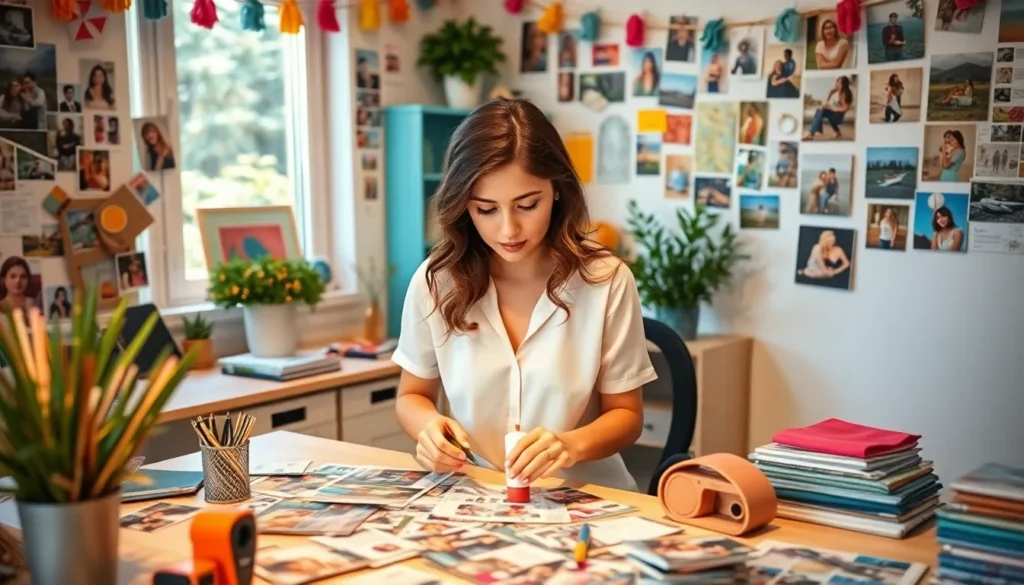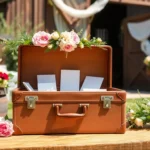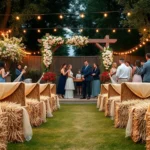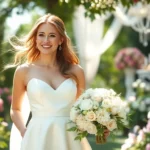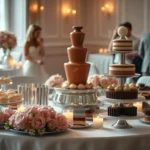Planning your dream wedding can feel overwhelming with countless decisions to make and details to coordinate. That’s where wedding vision boards become your secret weapon for turning scattered Pinterest pins and magazine clippings into a cohesive wedding plan that truly reflects your style.
We’ve discovered that creating a visual roadmap helps couples stay focused on what matters most while avoiding costly design mistakes. Whether you’re dreaming of an intimate garden ceremony or a glamorous ballroom reception, a well-crafted vision board keeps your ideas organized and your vendors aligned with your vision.
From color palettes and floral arrangements to venue layouts and dress silhouettes, we’ll show you how to transform your wedding fantasies into actionable inspiration. These creative vision board ideas will help you communicate your style clearly and make confident decisions throughout your planning journey.
Create a Digital Wedding Vision Board Using Pinterest and Canva
Digital platforms make creating comprehensive wedding vision boards easier than ever before. We’ll show you how to harness Pinterest’s discovery features and Canva’s design tools to build a stunning visual guide for your special day.
Setting Up Your Pinterest Wedding Board
Create a secret board to keep your ideas private during the initial brainstorming phase. Pinterest allows you to add up to 500,000 pins per board, giving you unlimited space to collect inspiration images, vendor photos, and styling ideas.
Name your board strategically using exact keywords like “Rustic Fall Wedding 2025” or “Modern Minimalist Reception Ideas” to help you stay focused on your chosen theme. We recommend creating separate boards for different wedding elements if you’re exploring multiple styles.
Enable rich pins by connecting your Pinterest account to your wedding website or blog. This feature displays additional details like pricing, availability, and vendor contact information directly on your pins, making vendor research more efficient.
Invite your partner and wedding party to collaborate on the board by adding them as contributors. Pinterest tracks who adds each pin, helping you identify which ideas resonate most with your planning team.
Use Pinterest’s search filters to find pins by color, date, and source to refine your inspiration hunting. The platform’s visual search tool lets you upload photos and find similar images, perfect for matching exact design details you’ve spotted elsewhere.
Using Canva Templates for Custom Designs
Browse Canva’s wedding template library featuring over 1,000 professionally designed layouts for invitations, mood boards, and planning documents. Templates range from elegant script designs to modern geometric patterns, ensuring you’ll find options that match your wedding aesthetic.
Customize color palettes within templates to reflect your chosen wedding colors perfectly. Canva’s color palette generator suggests complementary shades and provides hex codes you can share directly with vendors for accurate color matching.
Add your own photos to templates by uploading engagement photos, venue images, and inspiration shots from Pinterest. The drag and drop interface makes it simple to replace template photos with your personal content.
Create branded elements using Canva’s brand kit feature to maintain consistency across all your wedding materials. Save your wedding fonts, colors, and logo elements to apply the same styling to save the dates, invitations, and day of stationery.
Export in multiple formats including PDF for printing, PNG for social sharing, and JPEG for vendor communication. Canva Pro users can resize designs instantly to create matching materials in different dimensions for various applications.
Organizing Digital Elements by Category
Sort pins into themed sections within Pinterest boards using categories like “Ceremony Decor,” “Reception Lighting,” and “Bridal Fashion.” Pinterest allows up to 50 sections per board, giving you detailed organization options for comprehensive planning.
Create color coded folders in your computer’s file system to store downloaded images, vendor contracts, and inspiration photos. We suggest using the same color coding system across Pinterest, Canva, and your local files for seamless organization.
Label images with descriptive filenames including vendor names, pricing information, and style details. Instead of “IMG_1234.jpg,” use names like “ivory_roses_centerpiece_bella_flora_$75.jpg” for instant recognition later.
Track inspiration sources by creating a spreadsheet that links each design element to its original source, including vendor contact information and pricing details. This system prevents lost inspiration and streamlines vendor outreach when you’re ready to book services.
Archive completed elements by moving finalized decisions to a separate “Booked” folder or Pinterest board section. This visual progress tracking helps you see how much planning you’ve completed and what decisions still need attention.
Design a Physical Vision Board with Magazine Clippings and Photos
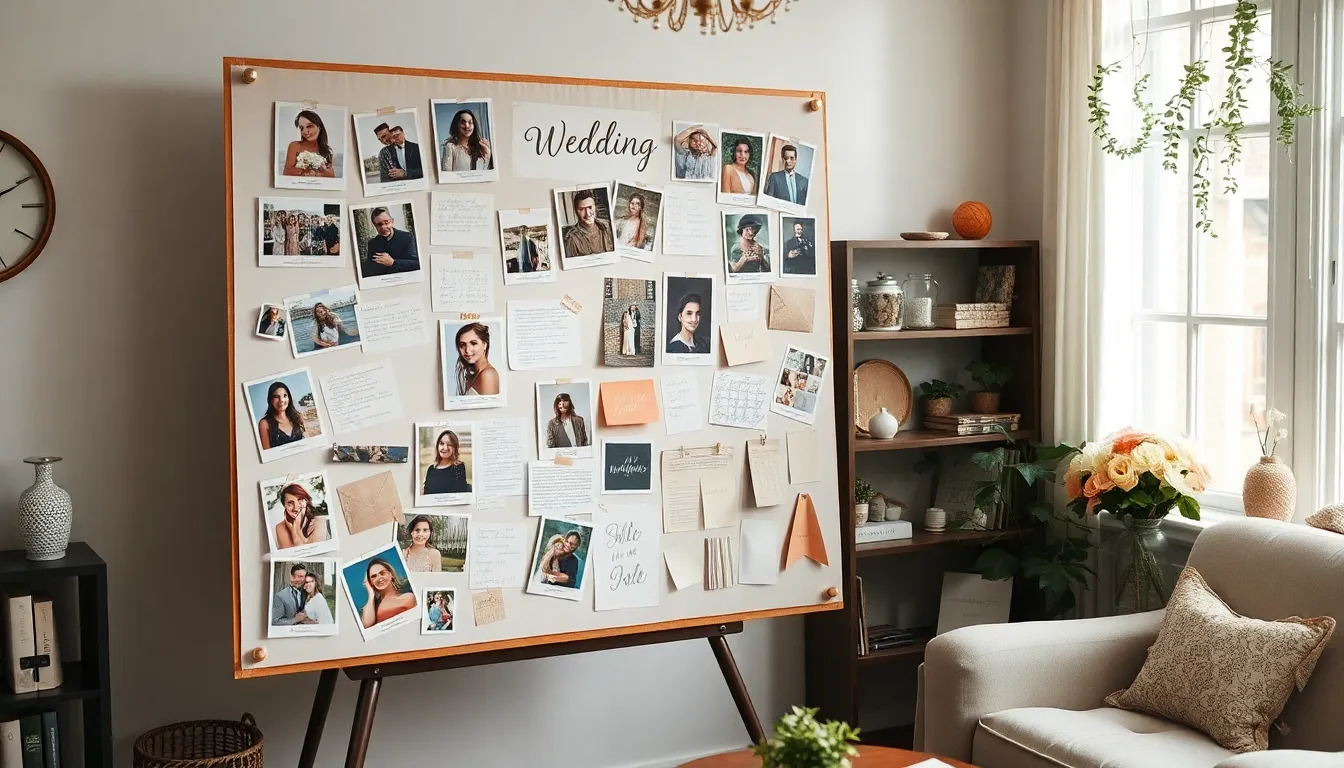
Creating a tangible wedding vision board brings your digital inspiration into the physical industry. The tactile experience of handling materials and arranging elements by hand offers a unique creative process that many couples find more captivating than digital alternatives.
Gathering Wedding Magazines and Print Materials
Start your collection by purchasing recent wedding magazines from popular publications like Martha Stewart Weddings, The Knot, and Brides. Local bookstores and grocery stores typically stock 15-20 current wedding magazine titles that showcase the latest trends and seasonal inspiration.
Search for images that reflect your exact style preferences including venue types, color schemes, floral arrangements, and fashion choices. We recommend collecting materials over 2-3 months to build a comprehensive resource library before beginning your board assembly.
Include fabric samples and ribbon swatches from create stores or wedding suppliers to add texture and dimension to your vision board. These tactile elements help you visualize how different materials will look and feel together on your actual wedding day.
Print high-resolution photos from your engagement session or meaningful locations to personalize your board with authentic memories. Professional photographers often provide digital galleries that allow you to select and print exact images at various sizes.
Creating a Cohesive Layout on Poster Board
Select a large poster board measuring at least 22×28 inches to provide adequate space for all your collected materials and inspiration pieces. Art supply stores offer poster boards in various colors, though white or cream backgrounds work best for showcasing colorful wedding elements.
Arrange all materials on the board without adhering them initially to experiment with different layout configurations and visual balance. This trial process typically takes 30-45 minutes and allows you to move elements around until you achieve a harmonious composition.
Organize your board into themed sections such as ceremony details, reception decor, fashion choices, and color palette examples. Creating distinct areas helps maintain visual organization while ensuring all important wedding elements receive appropriate representation.
Consider the visual weight of each element by balancing large images with smaller details and ensuring color distribution feels intentional throughout the board. Place your most important inspiration pieces in prominent positions where they’ll catch your eye during planning sessions.
Adding Personal Photos and Mementos
Incorporate printed photos from meaningful locations like your proposal site, favorite restaurant, or hometown landmarks that inspire your wedding aesthetic. These personal touches transform a generic inspiration board into a uniquely meaningful planning tool.
Attach fabric swatches from potential wedding dress materials or bridesmaid dress options to create tactile reference points during vendor meetings. Small fabric squares measuring 2×2 inches provide adequate samples without overwhelming your board’s visual balance.
Include handwritten notes and inspirational quotes that capture your emotions and vision for the wedding day. Calligraphy or elegant handwriting adds a personal artistic element while documenting exact ideas you want to remember throughout the planning process.
Add small keepsakes like pressed flowers from your engagement location or ticket stubs from memorable dates to create emotional connections within your vision board. These sentimental elements serve as daily reminders of your love story while you plan your celebration.
Include Color Palette Inspiration for Your Wedding Theme
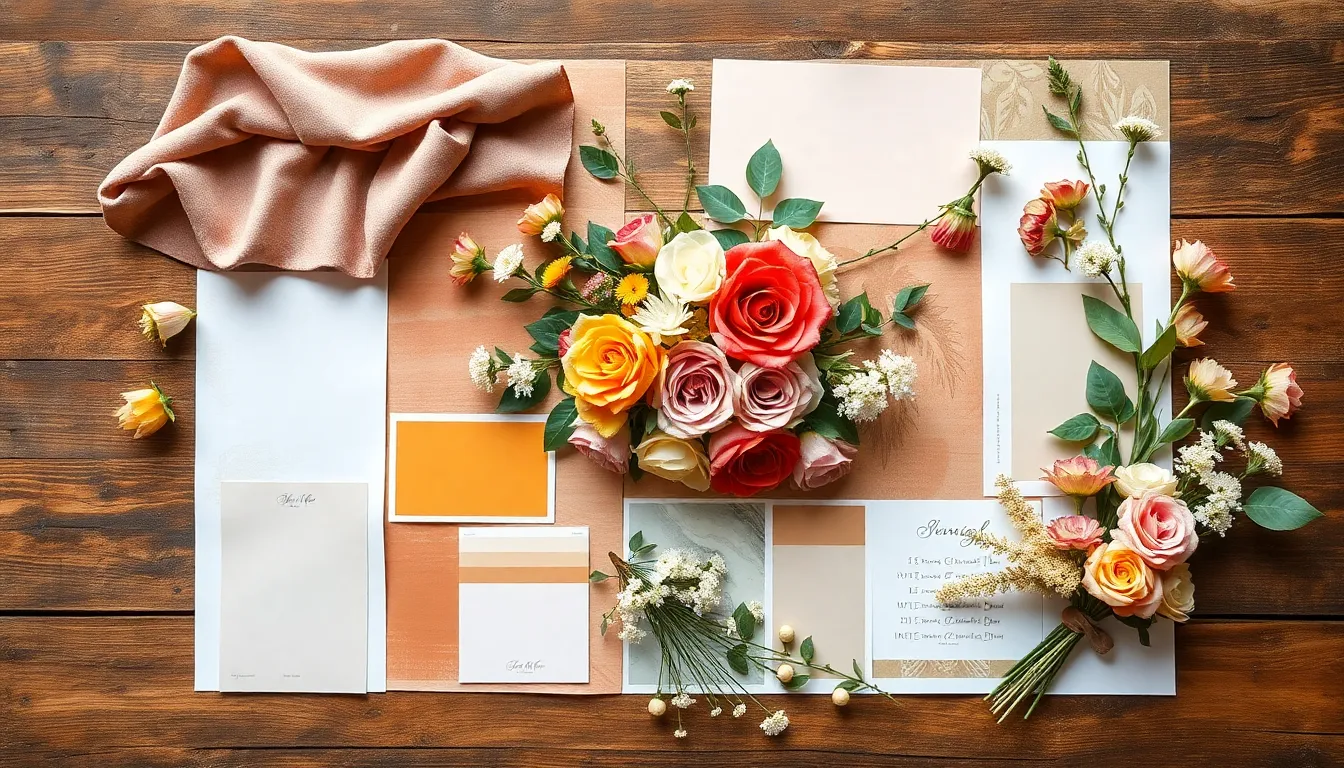
Color palettes serve as the foundation for unifying your entire wedding aesthetic and ensuring visual harmony across all elements. We’ll explore strategic approaches to selecting and incorporating colors that reflect your personal style while creating a cohesive celebration.
Selecting Your Primary and Secondary Colors
Choose one dominant color as your primary anchor that will appear most frequently throughout your wedding decor, attire, and invitations. This foundational hue should reflect the mood you want to create, whether that’s romantic pastels, luxurious jewel tones, or rustic earth shades.
Complement your primary color with one to three secondary hues that enhance rather than compete with your main choice. These supporting colors work beautifully for bridesmaid dresses, floral arrangements, and accent pieces like table runners or ceremony arch details.
Test color combinations using the 60-30-10 rule where your primary color dominates 60% of your design elements, secondary colors fill 30%, and accent colors complete the remaining 10%. This balanced approach prevents any single color from overwhelming your wedding vision board.
Incorporating Seasonal Color Trends
Spring weddings shine with light pinks, lilacs, and mint greens that capture the fresh energy of blooming gardens and new beginnings. These soft hues pair beautifully with white linens and natural wood accents for an organic feel.
Summer celebrations favor bright, bold colors like coral, teal, and sunny yellow that reflect the season’s vibrant energy and longer daylight hours. Bold combinations create stunning contrast against outdoor venues and beach settings.
Autumn palettes embrace warm, rich tones including burgundy, mustard, and rust that mirror the changing leaves and harvest season. These deeper colors create intimate atmospheres perfect for cozy indoor receptions.
Winter weddings often feature silvers, deep blues, and classic whites that complement the season’s elegant simplicity. Metallic accents and jewel tones add warmth and sophistication to cold weather celebrations.
Adding Fabric Swatches and Paint Samples
Attach physical fabric swatches directly to your vision board to understand how different textures interact with your chosen colors. Velvet samples appear richer than cotton in the same shade, while silk creates different light reflection than linen.
Include paint samples from home improvement stores to visualize exact color matches for DIY projects like welcome signs, ceremony backdrops, or reception centerpieces. These free samples help ensure consistency across all decorative elements.
Use HEX or RGB color codes for digital vision boards to maintain precision when sharing your palette with vendors and wedding party members. Digital codes eliminate guesswork and ensure accurate color reproduction across different devices and printing methods.
Create a color reference chart that combines fabric swatches, paint samples, and flower photos to demonstrate how your palette translates across different materials and lighting conditions. This comprehensive reference guides decision making throughout your planning process.
Feature Venue and Decor Ideas That Match Your Style
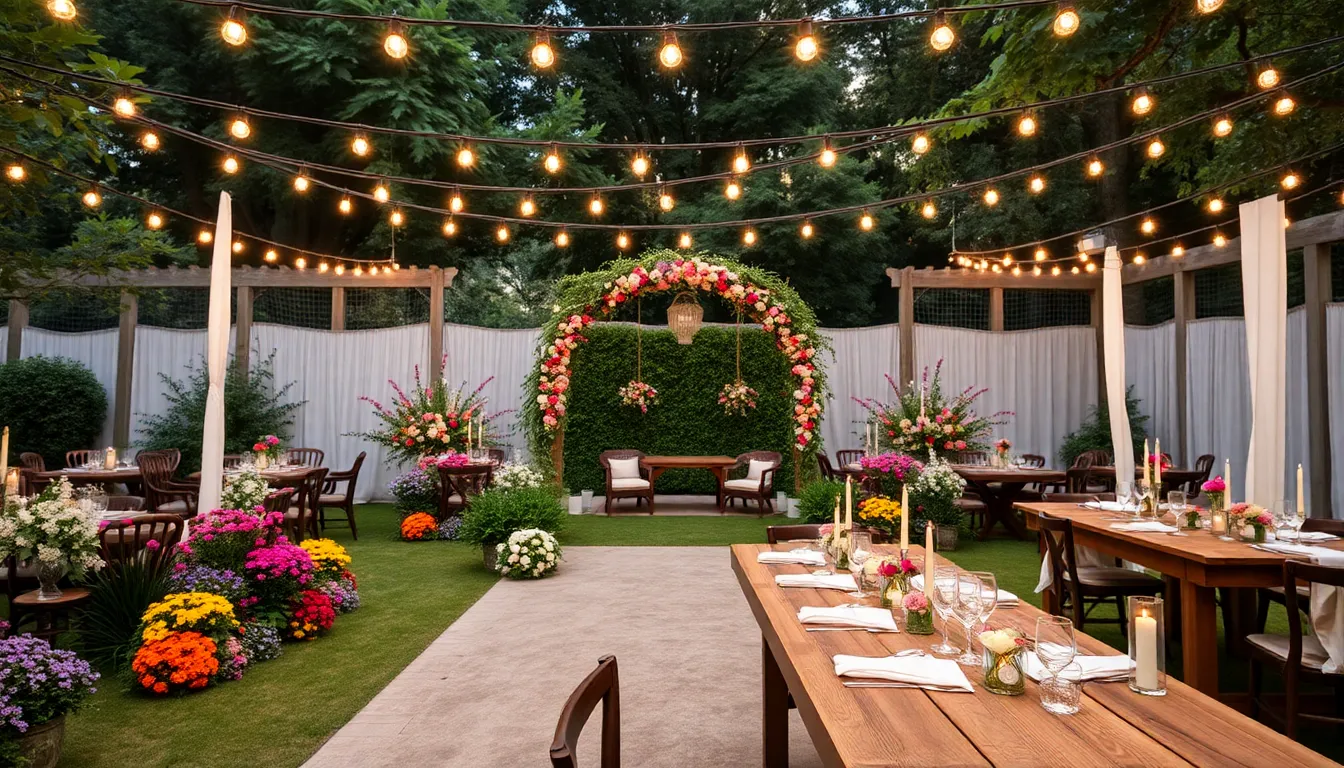
We’ll now explore how to showcase exact venue types and decor elements that align perfectly with your wedding aesthetic. Your vision board should capture the essence of both your ideal setting and the decorative details that’ll bring your celebration to life.
Indoor vs Outdoor Wedding Aesthetics
Indoor venues offer us controlled environments where we can create intimate, sophisticated atmospheres. We should include images of opulent ballrooms with crystal chandeliers, cozy halls with exposed wooden beams, or sleek modern event spaces featuring floor-to-ceiling windows. These photos help us visualize how our color palette and decor elements will work within enclosed spaces.
Outdoor settings provide natural backdrops that complement organic wedding themes beautifully. We can incorporate photos of lush gardens with flowering archways, pristine beaches with ocean views, or majestic mountain landscapes that create dramatic ceremony settings. These venue inspirations help us understand how lighting and weather conditions might affect our decor choices.
Weather considerations play crucial roles in outdoor wedding planning. We should add backup venue photos to our vision boards, showing how tented receptions or covered pavilions can maintain our aesthetic vision during unpredictable weather conditions.
Centerpiece and Table Setting Inspirations
Floral centerpieces serve as focal points that tie together our overall design scheme. We can include pictures of towering arrangements with cascading blooms, low-profile designs that encourage conversation, or unique combinations featuring succulents and air plants for modern weddings.
Alternative centerpiece ideas offer creative alternatives to traditional flower arrangements. We should consider images of elegant candelabras with pillar candles, vintage books paired with small bud vases, or geometric terrariums filled with seasonal elements.
Table setting elements create cohesive dining experiences that reflect our personal style. We can add photos of crisp white linens with gold-rimmed charger plates, rustic wooden tables with burlap runners, or colorful tablescapes featuring patterned napkins and mixed glassware.
Place setting details add personal touches that guests will remember. We should include images of handwritten place cards, small favor boxes at each setting, or custom menu cards that match our wedding stationery.
Lighting and Ambiance Elements
String lights create magical atmospheres that work beautifully for both indoor and outdoor celebrations. We can feature photos of bistro lights strung overhead, delicate fairy lights wrapped around trees, or Edison bulb installations that add industrial charm to rustic venues.
Candle arrangements provide warm, romantic lighting that enhances intimate moments. We should include images of pillar candles in hurricane vases, floating candles in glass bowls, or rows of votive candles lining ceremony aisles.
Lantern displays offer versatile lighting answers that complement various wedding themes. We can add photos of paper lanterns in soft pastels, metal lanterns with flickering candles, or Moroccan-inspired fixtures that create exotic ambiance.
Natural lighting elements work particularly well for outdoor ceremonies and receptions. We should consider images of open fires in stone fire pits, torch lighting along pathways, or sunset ceremonies that take advantage of golden hour lighting.
Add Bridal Fashion and Groom Style Inspirations
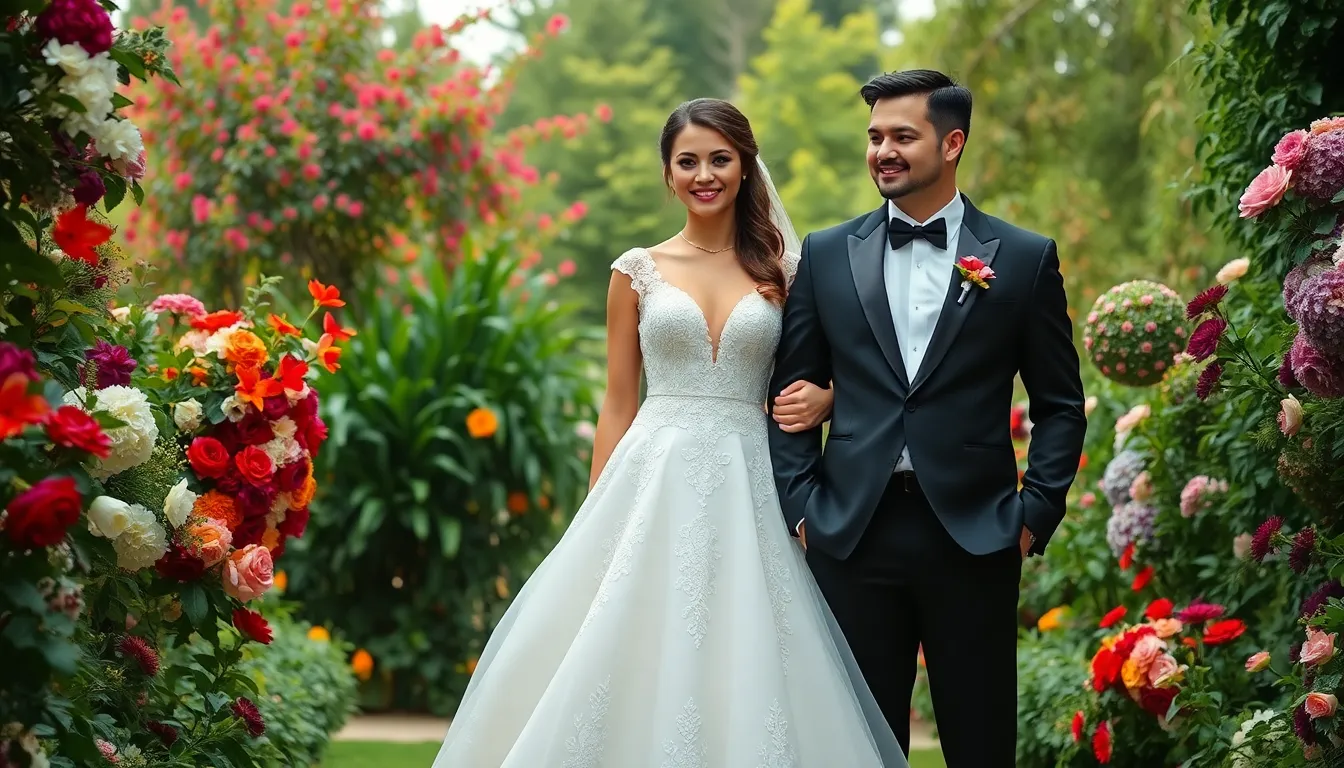
Fashion inspirations form the visual foundation of your wedding vision board. These elements help define your style direction and create a cohesive aesthetic that flows from ceremony to reception.
Wedding Dress Silhouettes and Styles
Bridal dress silhouettes shape the entire wedding aesthetic, and your vision board should showcase various options to help narrow down your perfect look. A-line dresses offer timeless elegance and flatter most body types, while ballgowns create dramatic princess moments with voluminous skirts. Mermaid silhouettes hug curves before flaring at the knee, and sheath dresses provide sleek sophistication for modern brides. Fit-and-flare styles combine comfort with feminine charm, making them ideal for outdoor celebrations.
Style inspirations range from romantic to contemporary, allowing you to express your personality through fabric choices and embellishments. Romantic lace designs feature intricate patterns and delicate details that photograph beautifully in natural light. Sleek minimalist gowns emphasize clean lines and architectural elements for sophisticated ceremonies. Bohemian styles incorporate flowing fabrics, nature-inspired details, and relaxed silhouettes perfect for garden weddings. Traditional satin options provide classic glamour with smooth textures and elegant draping.
Fabric swatches and embellishment samples deserve dedicated space on your vision board to compare textures and visual impact. Add small pieces of tulle, chiffon, crepe, and silk to understand how different materials photograph and move. Include examples of beadwork, embroidery, and lace appliques to visualize potential dress details. Compare neckline options like sweetheart, off-the-shoulder, halter, and high-neck styles using magazine cutouts and photos.
Groom’s Attire and Accessory Options
Groom attire choices establish the formality level and complement your bridal style vision perfectly. Tuxedos create classic black-tie elegance with satin lapels and formal accessories, while contemporary suits offer versatility in various colors and fabrics. Wool suits provide structure and sophistication for traditional ceremonies, and linen options bring relaxed elegance to beach or garden weddings. Velvet fabrics add texture and luxury for evening celebrations or winter events.
Color palettes extend beyond traditional black and gray to include navy, charcoal, burgundy, and even bold jewel tones for adventurous couples. Include fabric swatches in different hues to see how they coordinate with your wedding colors and bridal dress choice. Add images of seasonal variations like lighter colors for spring weddings and deeper tones for autumn celebrations.
Accessory coordination completes the groom’s polished appearance and ties into your overall wedding aesthetic. Ties, bowties, pocket squares, and suspenders provide opportunities to incorporate wedding colors and personal style elements. Cufflinks, watches, and shoes contribute finishing touches that photograph well in detail shots. Include examples of coordination options like matching the boutonniere to bridal bouquet elements or incorporating family heirloom pieces.
Bridal Party Outfit Coordination
Bridal party coordination creates visual harmony while allowing individual personalities to shine through your vision board planning. Matching color palettes for bridesmaids’ dresses ensure cohesive photos while offering flexibility in dress styles and silhouettes. Include fabric swatches in your chosen palette with variations in shade depth to accommodate different skin tones and preferences.
Groomsmen coordination extends beyond matching ties to include vest colors, pocket square patterns, and shoe styles that complement the overall aesthetic. Add examples of how accessories can tie the wedding party together, such as coordinating boutonnieres, cufflinks, or lapel pins. Consider seasonal elements like lighter fabrics for summer weddings or deeper colors for autumn celebrations.
Mix and match approaches allow bridal party members to express individual style while maintaining visual cohesion. Include examples of different dress lengths, necklines, or sleeve styles in the same color family. Add images showing how varying textures like chiffon, satin, and crepe can create visual interest while staying within your color palette. Consider complementary accessories like jewelry sets, shoes, or hair accessories that unify the overall look.
Incorporate Floral Arrangements and Bouquet Concepts
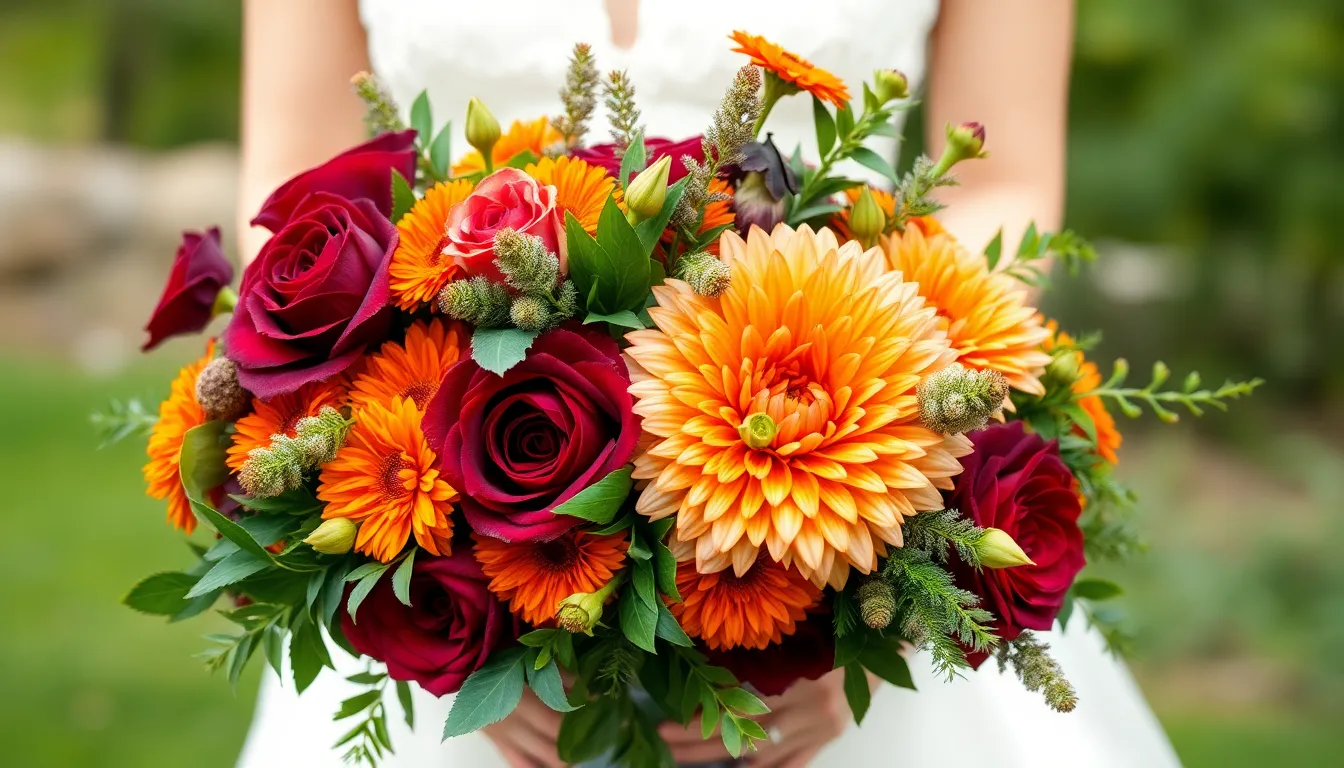
Floral elements serve as the living artwork of your wedding vision board, connecting your color palette with natural beauty that brings life to every celebration detail. We’ll explore how strategic flower choices can transform your wedding aesthetic from ordinary to extraordinary.
Seasonal Flower Selections
Spring blooms like peonies and roses create romantic elegance that perfectly captures renewal and fresh beginnings. These flowers offer soft textures and delicate fragrances that enhance intimate ceremony settings while providing stunning photographic opportunities.
Summer selections featuring sunflowers and dahlias bring vibrant energy and bold colors to outdoor celebrations. Zinnias and marigolds add cheerful brightness, while lavender contributes aromatic charm that guests will remember long after your special day.
Autumn arrangements showcase chrysanthemums, dahlias, and seasonal foliage that reflect the harvest season’s rich warmth. Deep burgundy roses paired with orange marigolds create sophisticated color combinations that complement fall’s natural beauty.
Winter florals including amaryllis, winter jasmine, and evergreen branches provide elegant structure during colder months. White roses mixed with silver eucalyptus create timeless sophistication, while red poinsettias add festive warmth to holiday season weddings.
Bouquet Shapes and Styles
Round bouquets offer classic versatility that complements most dress silhouettes and venue styles. This traditional shape works beautifully with roses, peonies, and hydrangeas, providing balanced proportions that photograph well from every angle.
Cascading arrangements create dramatic elegance with flowers that flow naturally downward like botanical waterfalls. Orchids, stephanotis, and trailing ivy work exceptionally well in this style, adding movement and sophistication to formal wedding gowns.
Hand tied bouquets deliver relaxed charm through loose, organic arrangements that feel effortlessly romantic. Wildflowers, garden roses, and herbs create textural interest while maintaining the natural, unstructured aesthetic that outdoor venues inspire.
Compact posies provide intimate charm for smaller celebrations or vintage themed weddings. These tightly arranged bouquets featuring spray roses, baby’s breath, or seasonal berries create sweet proportions that complement tea length dresses perfectly.
Ceremony and Reception Floral Designs
Garden ceremony settings call for lush greenery and wildflowers that blend seamlessly with natural surroundings. Flowing arrangements of foxglove, delphinium, and ferns create organic beauty that enhances outdoor venues without overwhelming the industry.
Church ceremony designs benefit from structured, traditional arrangements that respect the venue’s architectural dignity. Formal altar arrangements using white lilies, roses, and greenery provide elegant focal points that complement sacred spaces appropriately.
Reception centerpieces anchor each table’s design while reflecting your overall wedding theme through coordinated florals. Low arrangements allow easy conversation, while tall designs create dramatic height variation that adds visual interest throughout the reception space.
Hanging installations transform ordinary venues into enchanted spaces through suspended floral arrangements and greenery. Ceiling flowers, floral chandeliers, and overhead garlands create immersive environments that surround guests with natural beauty from every direction.
Plan Your Wedding Photography Style and Shot List
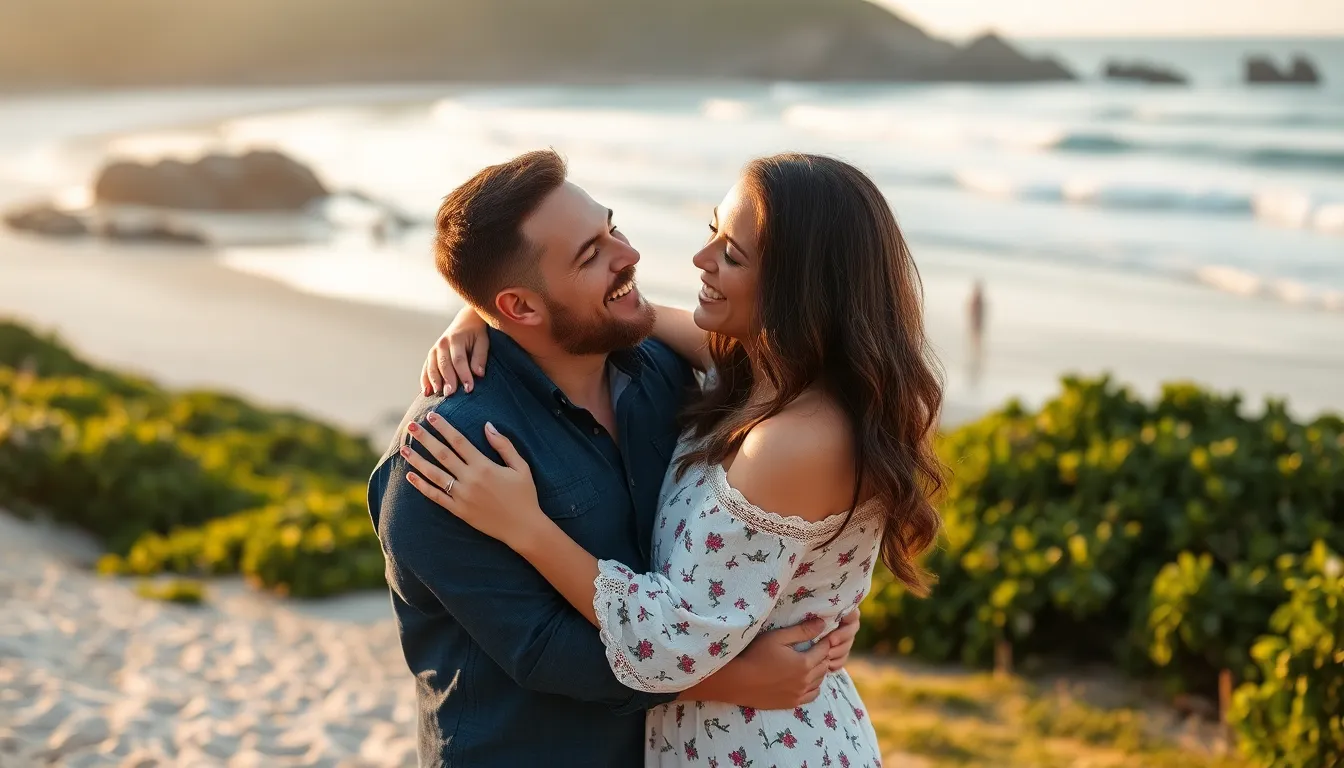
Photography captures the essence of your wedding day, preserving memories that’ll last a lifetime. Including exact photography styles and shot lists on your vision board ensures your photographer understands your preferences and captures every meaningful moment.
Engagement Photo Inspiration
Romantic photography styles create timeless images with soft lighting and intimate poses that showcase your connection. We recommend adding examples of dramatic lighting, candid documentary shots, and editorial-style portraits to guide your photographer’s approach.
Location inspirations should reflect your personality and relationship story. Beach settings offer natural beauty with golden hour lighting, while cityscapes provide urban backdrops with architectural elements. Park locations deliver lush greenery and seasonal variety that creates stunning natural frames.
Props and wardrobe suggestions elevate engagement sessions beyond basic portraits. Consider incorporating meaningful items like books, vintage furniture, or hobby-related objects that tell your story. Wardrobe coordination between partners creates visual harmony without being overly matchy.
Pose themes should feel authentic to your relationship ever-changing. Include examples of walking shots, sitting poses, and interactive moments that capture genuine emotions. Notes about your comfort level with physical affection help photographers plan appropriate poses.
Must-Have Wedding Day Moments
Essential ceremony moments form the emotional core of your wedding photography. First look reactions, vow exchanges, ring ceremonies, and the first kiss as married partners deserve prominent placement on your vision board. These moments happen once and require skilled timing to capture perfectly.
Family group photos need strategic planning to ensure everyone’s included. Add exact grouping combinations like immediate family, extended relatives, and generational photos to your shot list. Consider family dynamics and divorced parents when planning these arrangements.
Candid emotional shots often become the most treasured images from your wedding day. Include examples of tears during vows, laughter during speeches, and spontaneous reactions from guests. These unposed moments capture authentic emotions that posed photos can’t replicate.
Traditional customs deserve documentation if they’re meaningful to your heritage or beliefs. Unity ceremonies, cultural rituals, or religious traditions should be highlighted on your vision board with exact timing notes for your photographer.
Reception and Detail Photography Ideas
Tablescape and centerpiece shots showcase your design vision and investment in reception décor. Floral arrangements, lighting installations, and place settings create the atmosphere your guests will remember. Include close-up detail shots and wide-angle room views to capture both intimacy and grandeur.
Reception activities generate energy and joy that translates beautifully in photographs. First dance moments, cake cutting ceremonies, and toast reactions create narrative flow in your wedding album. Guest interactions during dancing and mingling capture the celebration’s spirit.
Décor details reflect your planning efforts and personal style choices. Signage, guestbooks, favor displays, and unique architectural elements of your venue deserve individual attention. These shots provide context and help tell your wedding’s complete visual story.
Lighting and ambiance photography requires exact techniques to capture mood accurately. String lights, candle arrangements, and architectural lighting create atmosphere that needs skilled exposure management. Include examples of how you want low-light reception moments captured.
Include Catering and Cake Design Inspirations
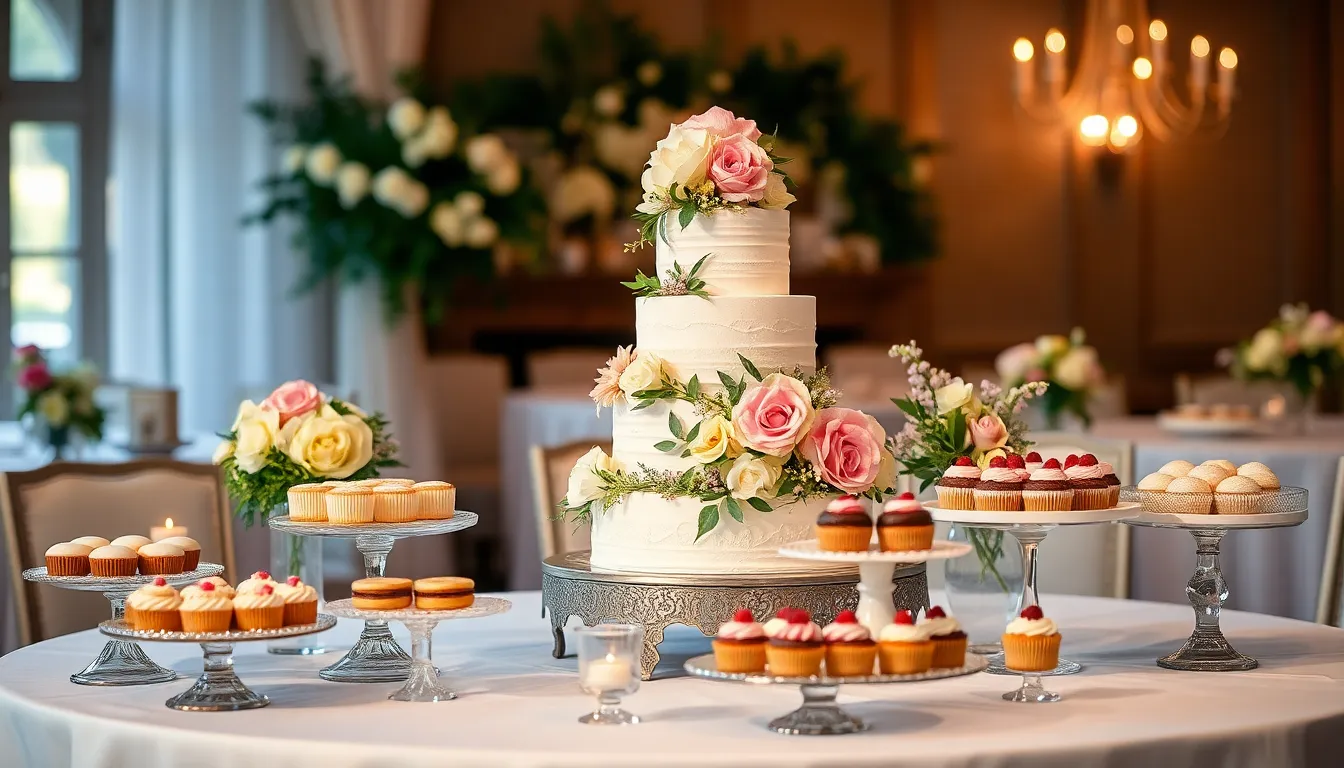
Culinary elements transform your wedding vision board into a comprehensive planning tool that captures the complete dining experience. We’ll explore how food presentation and dessert designs can enhance your overall wedding aesthetic.
Menu Style and Presentation Ideas
Buffet presentations offer versatility with layered textures and varying heights that create visual interest throughout your dining space. Station style dining allows guests to interact with chefs while sampling signature dishes that reflect your personality as a couple. Family style service encourages intimate conversation with shared platters featuring seasonal ingredients and locally sourced specialties.
Plated dinner presentations showcase elegant culinary artistry through carefully arranged components and sophisticated garnishing techniques. Menu cards placed at each setting can feature calligraphy that matches your wedding stationery for seamless design continuity. Display boards near food stations provide an opportunity to incorporate your wedding colors through creative typography and decorative elements.
Interactive food experiences include live cooking demonstrations, custom pasta stations, or build your own taco bars that engage guests throughout the reception. Incorporate natural elements like fresh herbs, seasonal flowers, or wooden serving platters that complement your venue’s atmosphere. Consider dietary preferences by featuring vegetarian, vegan, and gluten free options presented with the same attention to visual appeal as traditional dishes.
Wedding Cake Designs and Flavors
Classic tiered designs remain timeless with intricate piping work, delicate lace patterns, and pearl detailing that photograph beautifully against any backdrop. Semi naked cakes adorned with fresh flowers or cascading greenery create rustic elegance that works perfectly for outdoor venues and garden ceremonies. Modern geometric shapes featuring clean lines and metallic accents suit contemporary wedding themes with their sophisticated minimalist appeal.
Flavor combinations trending in wedding celebrations include lavender honey, lemon elderflower, and salted caramel that offer guests sophisticated taste experiences beyond traditional vanilla and chocolate. Different flavors for each tier provide variety while allowing you to incorporate family recipes or meaningful flavor memories from your relationship. Consider seasonal ingredients like fresh berries for summer weddings or warm spices for autumn celebrations that connect your cake to the time of year.
Artistic techniques such as brushstroke designs, watercolor effects, and hand painted florals transform cakes into edible masterpieces that serve as reception centerpieces. Textured buttercream finishes create visual interest while maintaining the classic appeal that photographs well in various lighting conditions. Sugar flowers crafted to match your bridal bouquet create stunning continuity between ceremony and reception elements.
Dessert Table and Signature Cocktails
Dessert variety extends your sweet offerings beyond the wedding cake with macarons in wedding colors, mini tarts featuring seasonal fruits, and artisanal chocolate truffles that guests can enjoy throughout the evening. Cupcake displays arranged on tiered stands create height variation while allowing for multiple flavor options that cater to different taste preferences. Cake pops and petit fours offer bite sized indulgences that guests can easily enjoy while mingling and dancing.
Styling coordination ensures dessert tables complement your overall design aesthetic through matching linens, floral arrangements, and serving pieces that reflect your chosen color palette. Height variation created with cake stands, glass cylinders, and decorative boxes adds visual dimension while maximizing table space for additional treats. Incorporate personal touches like family recipe cards or photos from your engagement session to create meaningful connections between your story and the celebration.
Signature cocktails named after meaningful locations, shared memories, or pet names add personality while providing conversation starters for guests throughout the reception. Custom glassware featuring your monogram or wedding date creates lasting keepsakes while improving the visual presentation of your bar service. Garnishes coordinated with your wedding flowers like lavender sprigs, citrus wheels, or herb bouquets tie your cocktail presentation into the overall floral design scheme.
Drink presentation includes creative menu displays on chalkboards, acrylic signs, or vintage frames that match your wedding stationery and provide clear information about ingredients for guests with allergies. Specialty ice cubes featuring frozen flowers or herbs elevate simple cocktails into Instagram worthy creations that guests will remember long after the celebration ends.
Add Timeline and Budget Planning Elements
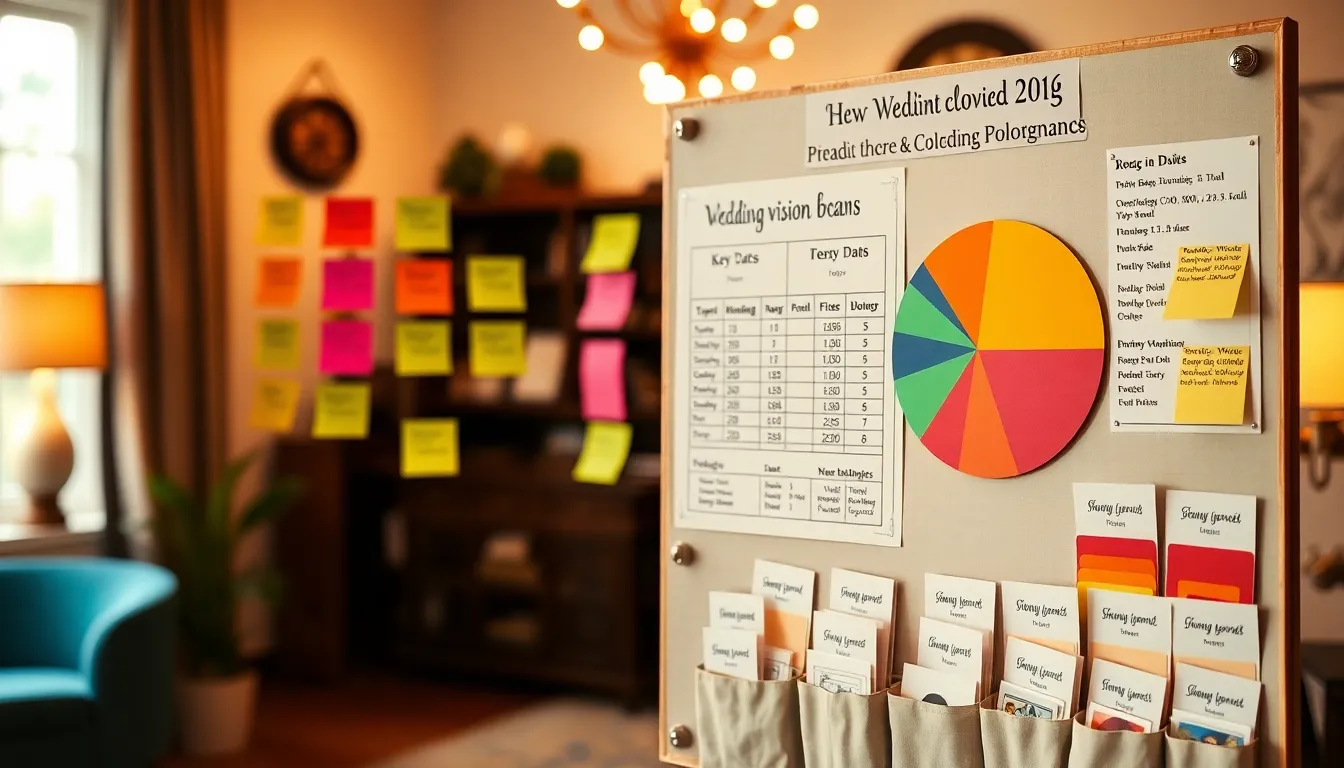
Transform your wedding vision board into a comprehensive planning tool by incorporating practical elements that keep you organized and on track. These strategic additions help you manage your wedding timeline and budget while maintaining your creative inspiration.
Wedding Planning Milestone Dates
Create a visual timeline by adding key planning dates directly to your vision board using colorful sticky notes or dedicated sections. We recommend including your engagement party date, venue booking deadline, dress shopping appointments, and final guest count confirmation. Mark your cake tasting sessions and floral arrangement consultations to ensure you don’t miss these crucial vendor meetings.
Highlight your countdown milestones with special markers or decorative elements that show 12 months, 6 months, 3 months, and 1 month before your wedding day. We suggest using different colors for each milestone to create visual distinction. Include your rehearsal dinner planning date and bachelor/bachelorette party weekends to coordinate with your wedding party’s schedules.
Track your RSVP deadline prominently on your board since this affects your final headcount and catering arrangements. We find that couples often forget to account for vendor final payment dates, so include these critical financial deadlines. Schedule your final dress fitting and groom’s attire pickup dates to ensure everything fits perfectly on your special day.
Budget Allocation Visual Guides
Design a simple pie chart showing how your wedding budget breaks down across major categories like venue (40%), catering (30%), photography (10%), and other expenses. We recommend using your wedding colors to make this budget visualization cohesive with your overall aesthetic. Create percentage bars for each category to see at a peek where your money is going.
Include actual dollar amounts alongside percentages to keep spending realistic and trackable throughout your planning process. We suggest updating these figures monthly as you book vendors and finalize contracts. Use visual cues like green for under budget, yellow for on target, and red for over budget to quickly assess your financial status.
Add a contingency fund section representing 5-10% of your total budget for unexpected expenses that always arise during wedding planning. We find that couples who visualize their emergency fund are less stressed when small additional costs appear. Track your deposits and final payments with checkboxes or progress bars to see your financial commitments at a peek.
Vendor Contact Information Layout
Organize business cards in a dedicated section of your vision board using small pockets or plastic sleeves that keep vendor information easily accessible. We recommend grouping cards by vendor type: photographers, florists, caterers, and musicians. Create a contact grid with vendor names, phone numbers, email addresses, and contract dates in a clean, readable format.
Include vendor Instagram handles or website URLs since many wedding professionals showcase their latest work on social media platforms. We suggest adding small photos of each vendor’s work samples directly next to their contact information. Note your preferred communication method for each vendor, whether they respond better to calls, texts, or emails.
Track your vendor meetings with a simple calendar or checklist showing consultation dates, contract signing deadlines, and final walkthrough appointments. We find that visual organization prevents double booking and helps you prepare for each vendor interaction. Add payment schedules for each vendor so you know when deposits and final payments are due without searching through multiple contracts.
Create Honeymoon and Travel Inspiration Sections

Your wedding vision board shouldn’t end with the reception—it’s the perfect place to visualize your first adventure as newlyweds. Adding honeymoon and travel inspiration sections helps you plan the romantic getaway that perfectly complements your wedding style and creates excitement for what comes after the big day.
Destination Ideas and Activities
Tropical beaches offer the ultimate romantic escape with pristine white sands and crystal-clear waters. Pin images of destinations like Bora Bora, Maldives, or Santorini to capture that dreamy beachfront vibe. Add photos of activities you’d love to try together—snorkeling through coral reefs, sunset sailing, or couples’ spa treatments on the beach.
European cities provide cultural richness and architectural beauty for couples seeking sophisticated adventures. Collect visuals of Paris cafes, Tuscan vineyards, or Prague’s historic squares. Include activity inspiration like wine tastings in Bordeaux, cooking classes in Rome, or art museum tours in Amsterdam.
Mountain retreats create intimate settings surrounded by breathtaking natural landscapes. Gather photos of cozy cabins in Aspen, Swiss chalets, or New Zealand’s dramatic fjords. Add adventure activities such as hiking scenic trails, hot air balloon rides, or stargazing sessions under clear mountain skies.
Adventure destinations cater to couples who crave excitement and unique experiences together. Pin images of African safaris, Costa Rican rainforests, or Japanese cultural experiences. Include thrilling activities like zip-lining through canopies, wildlife photography, or traditional tea ceremonies.
Romantic Accommodation Inspirations
Overwater bungalows provide ultimate privacy with direct ocean access and stunning panoramic views. Add photos of Tahitian resorts, Maldivian water villas, or Fiji’s luxury retreats. Include amenities like glass floor panels for fish watching, private decks with outdoor showers, or infinity pools overlooking the lagoon.
Boutique hotels offer intimate settings with personalized service and unique architectural charm. Gather images of Moroccan riads, Greek island hotels, or historic European inns. Focus on special features like rooftop terraces, private courtyards, or rooms with fireplaces and four-poster beds.
Luxury resorts deliver comprehensive experiences with industry-class amenities and exceptional service. Pin photos of all-inclusive Caribbean resorts, Hawaiian beachfront properties, or Balinese jungle retreats. Highlight spa services, multiple dining options, private beach access, or championship golf courses.
Unique stays create unforgettable memories through extraordinary accommodations and one-of-a-kind experiences. Include images of treehouses in Costa Rica, igloos in Finland, or safari tents in Kenya. Add special touches like private butler service, guided nature walks, or exclusive access to local attractions.
Travel Planning and Packing Lists
Essential documents ensure smooth travel without last-minute stress or complications. Create a checklist including passports, visas, travel insurance, marriage certificates, and driver’s licenses. Add backup copies stored separately and digital versions saved to your phone or cloud storage.
Climate-appropriate clothing keeps you comfortable while looking great in honeymoon photos. Pin packing guides for tropical destinations featuring lightweight fabrics, swimwear, and sun protection. Include mountain retreat essentials like layered clothing, hiking boots, and warm accessories for evening temperatures.
Activity-exact gear enhances your planned experiences and ensures you’re properly prepared. Add lists for snorkeling equipment, hiking gear, formal dining attire, or photography equipment. Include versatile pieces that work for multiple activities to maximize luggage space.
Booking strategies help secure the best deals and ensure seamless travel arrangements. Pin tips for finding flight deals, hotel comparison websites, and travel package offers. Add advice for booking accommodations with honeymoon perks, travel insurance options, and currency exchange considerations for international destinations.
Conclusion
Your wedding vision board serves as more than just a planning tool—it’s the roadmap to your perfect day. Whether you choose digital platforms or physical boards we’ve shown you countless ways to bring your dreams to life through visual storytelling.
From color palettes and floral arrangements to venue styles and photography inspiration every element we’ve covered helps create a cohesive wedding aesthetic. Remember that your vision board should evolve as your planning progresses reflecting your unique style and personal touches.
Start creating your wedding vision board today and watch as your scattered ideas transform into a clear unified vision. With the right approach you’ll find that planning becomes more enjoyable and your dream wedding more attainable than ever before.
Frequently Asked Questions
What is a wedding vision board and why do I need one?
A wedding vision board is a visual collection of images, colors, and ideas that represent your dream wedding style. It helps streamline planning by organizing your thoughts, maintaining focus on your aesthetic, and preventing costly design mistakes. Vision boards also make it easier to communicate your vision to vendors and make confident decisions throughout the planning process.
Should I create a digital or physical wedding vision board?
Both options have benefits. Digital boards using Pinterest or Canva are easily shareable with vendors and allow collaboration with your partner. Physical boards offer a tactile experience and can be displayed as inspiration. Many couples create both – digital for sharing and organization, physical for the hands-on planning experience.
How do I choose the right color palette for my wedding?
Use the 60-30-10 rule: 60% primary color, 30% secondary color, 10% accent color. Consider seasonal trends and your personal style. Add fabric swatches and paint samples to your vision board for texture understanding. Create a color reference chart with HEX codes for digital precision when communicating with vendors.
What elements should I include in my wedding vision board?
Include color palettes, venue styles, fashion inspiration (bridal and groom attire), floral arrangements, photography styles, catering concepts, and cake designs. Also add practical elements like timeline planning, budget allocation visuals, and vendor contact information. Consider including honeymoon inspiration to visualize your post-wedding adventure.
How can I organize my wedding vision board effectively?
Sort Pinterest pins into themed sections and create color-coded folders on your computer. Label images descriptively and track inspiration sources with a spreadsheet. Archive completed elements to visualize progress. For physical boards, organize materials into themed sections and balance visual weight for aesthetic appeal.
What photography elements should I include on my vision board?
Include engagement photo inspirations, must-have wedding day moments (first looks, family photos), candid emotional shots, and reception detail photography. Add examples of photography styles you prefer and create a shot list. This helps photographers understand your vision and ensures they capture every meaningful moment.
How do I incorporate seasonal elements into my wedding vision board?
Choose flowers that bloom in your wedding season – spring peonies, summer sunflowers, autumn chrysanthemums, or winter amaryllis. Consider seasonal color trends and weather conditions for outdoor venues. Add seasonal decor elements and lighting options that complement the time of year you’re getting married.
Can I use my vision board for budget and timeline planning?
Yes! Create visual timeline elements with key planning dates using colorful sticky notes. Design budget allocation pie charts to track spending. Include vendor contact information and meeting schedules. Add RSVP deadlines and payment dates to stay organized throughout the planning process.

